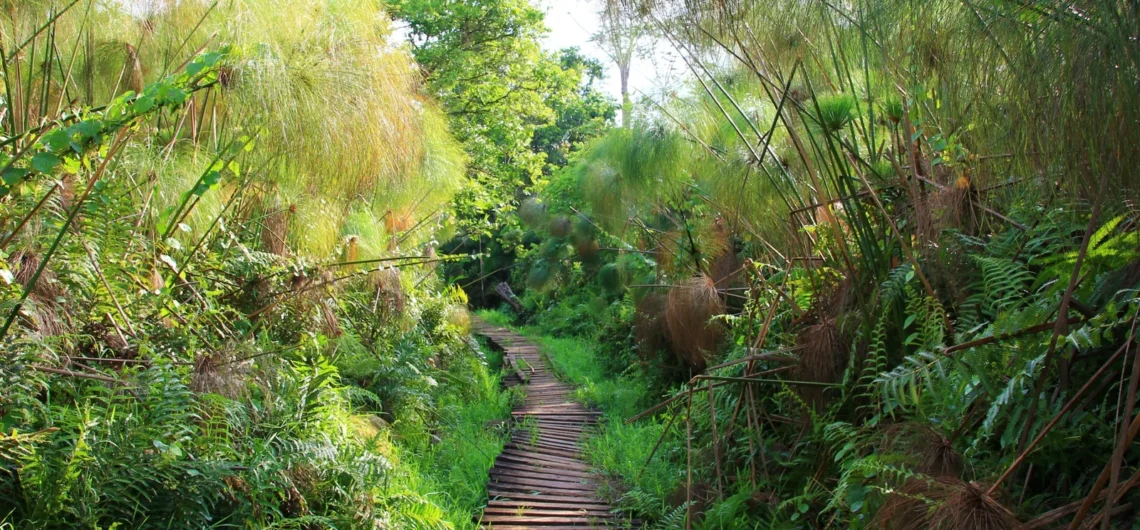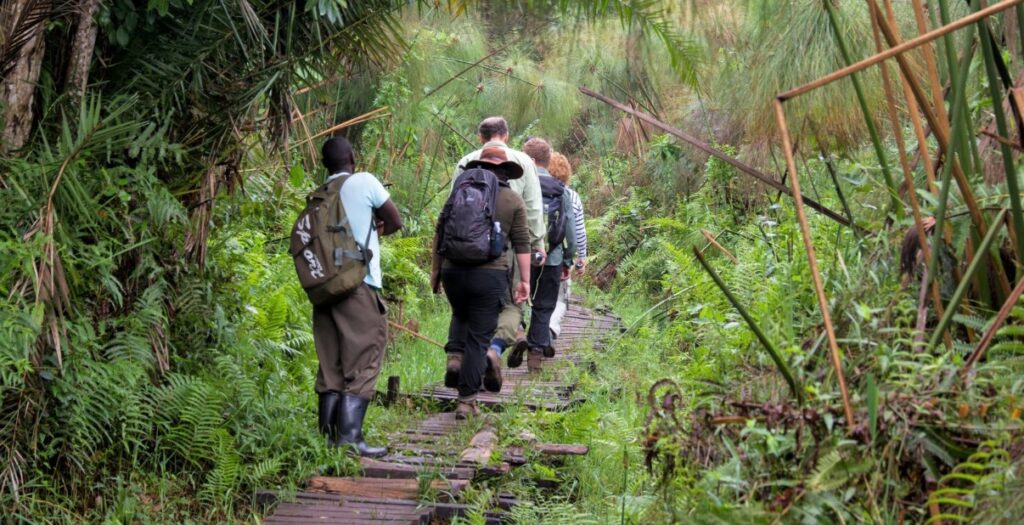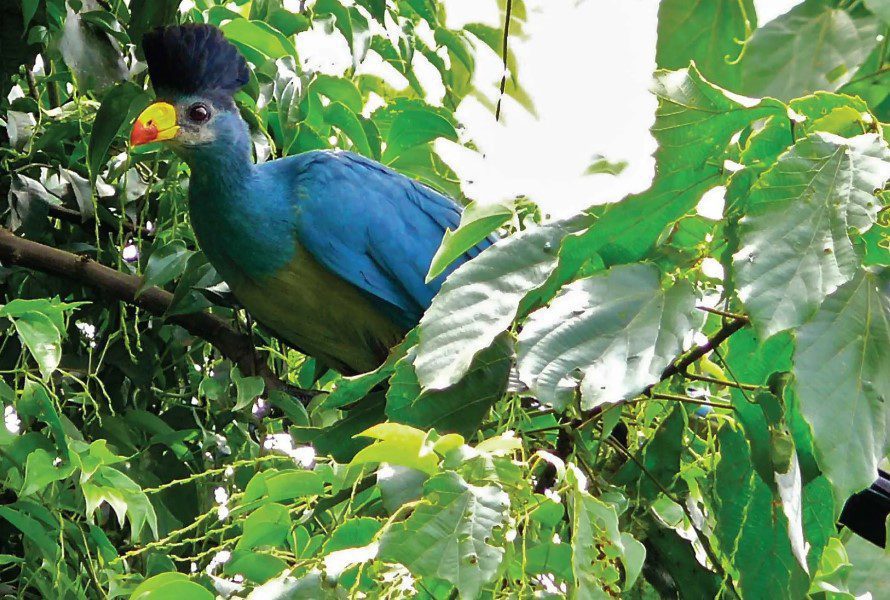Bigodi Wetland Sanctuary
Background
Bigodi Wetland Sanctuary is a community-based conservation project located in the western part of Uganda, near the famous Kibale National Park. The Kibale Association established it in 1992 for Rural and Environmental Development (KAFRED). The sanctuary covers an area of approximately 4 square kilometers and is a significant part of the Magombe Swamp. The initiative was started to protect the swamp’s biodiversity while promoting sustainable tourism and benefiting the local community.
How to Access Bigodi Wetland Sanctuary
The sanctuary is situated about 40 kilometers south of Fort Portal and 5 kilometers from the Kanyanchu Visitor Center of Kibale National Park. Here is how you can access it:
- By Road: You can reach the sanctuary by road from Kampala, Uganda’s capital, which is approximately a 5-6 hour drive (about 320 kilometers). The journey can be made using a private vehicle, rental car, or public transport.
- By Air: The nearest airstrip is in Kasese, about 70 kilometers away. From there, you can hire a taxi or use local transport to reach the sanctuary.
Attractions at Bigodi Wetland Sanctuary
- Biodiversity: Bigodi Wetland Sanctuary boasts rich biodiversity, including over 200 bird species such as the Great Blue Turaco, and 8 primate species like the Red Colobus Monkey and Grey-cheeked Mangabey. The sanctuary also hosts various mammals like otters and bushbucks, numerous plant species including wild palms and papyrus, and several reptiles. This diverse ecosystem makes it a prime destination for wildlife enthusiasts.
- Primates: It is home to eight primate species, including the Red Colobus Monkey, Black and White Colobus Monkey, L’Hoest’s Monkey, and Grey-cheeked Mangabey. Other primates seen here are the Blue Monkey, Vervet Monkey, Olive Baboon, and Chimpanzee. These primates thrive in the sanctuary’s lush, diverse habitat, offering excellent opportunities for observation and study.
- Flora: Bigodi Wetland Sanctuary’s flora includes diverse plant species such as wild palms, polita figs, and towering papyrus plants. The lush vegetation provides essential habitat and food sources for the sanctuary’s wildlife, contributing to its rich biodiversity.
- Mammals and Reptiles: Bigodi Wetland Sanctuary hosts a variety of mammals like otters, bushbucks, and mongooses. It also features several reptile species, contributing to the area’s diverse ecosystem and providing many opportunities for wildlife observation.
Activities at Bigodi Wetland Sanctuary
- Guided Nature Walks:
 Experienced local guides who provide insights into the area’s ecology and cultural significance lead them and they usually lake 2-3 hours. These walks offer opportunities to observe a variety of birds, primates, and other wildlife, as well as learn about the diverse plant species. The guides also share information on conservation efforts and the community’s role in protecting the wetland.
Experienced local guides who provide insights into the area’s ecology and cultural significance lead them and they usually lake 2-3 hours. These walks offer opportunities to observe a variety of birds, primates, and other wildlife, as well as learn about the diverse plant species. The guides also share information on conservation efforts and the community’s role in protecting the wetland. - Bird Watching:
 Bird watching in Bigodi Wetland Sanctuary is a prime activity, with over 200 bird species, including the Great Blue Turaco, making it a top destination for bird enthusiasts. Expert guides help spot and identify various birds during tours, enhancing the experience. The sanctuary’s rich avian diversity offers excellent opportunities for both novice and experienced bird watchers.
Bird watching in Bigodi Wetland Sanctuary is a prime activity, with over 200 bird species, including the Great Blue Turaco, making it a top destination for bird enthusiasts. Expert guides help spot and identify various birds during tours, enhancing the experience. The sanctuary’s rich avian diversity offers excellent opportunities for both novice and experienced bird watchers. - Cultural Tours: Visitors can engage with the local community, learning about their way of life, traditions, and the role of the wetland in their daily lives. This may include visits to a traditional healer, a local school, and craft shops.
- Primate Viewing: Primate viewing in Bigodi Wetland Sanctuary offers the chance to see eight species, including Red Colobus Monkeys, Grey-cheeked Mangabeys, and L’Hoest’s Monkeys. Guided tours help visitors observe these primates in their natural habitat, providing insights into their behavior and ecology. The sanctuary’s diverse environment supports a rich primate population, making it a prime spot for primate enthusiasts.
- Photography: The sanctuary offers excellent photography opportunities with its diverse wildlife, including birds, primates, and other mammals, set against lush vegetation and scenic landscapes. Guided tours enhance the experience by helping photographers spot and capture the best moments in this rich, natural habitat.
Conservation and Community Impact
Bigodi Wetland Sanctuary is a model of community-based conservation. The revenue generated from tourism is used to fund community projects such as schools, health centers, and infrastructure improvements. The project promotes environmental education and sustainable practices, ensuring the protection of the wetland for future generations.
Conclusion
Bigodi Wetland Sanctuary is not only a haven for biodiversity but also a successful example of how conservation and community development can go hand in hand. It offers visitors a unique opportunity to experience Uganda’s natural beauty and cultural richness while supporting local conservation efforts.


 Experienced local guides who provide insights into the area’s ecology and cultural significance lead them and they usually lake 2-3 hours. These walks offer opportunities to observe a variety of birds, primates, and other wildlife, as well as learn about the diverse plant species. The guides also share information on conservation efforts and the community’s role in protecting the wetland.
Experienced local guides who provide insights into the area’s ecology and cultural significance lead them and they usually lake 2-3 hours. These walks offer opportunities to observe a variety of birds, primates, and other wildlife, as well as learn about the diverse plant species. The guides also share information on conservation efforts and the community’s role in protecting the wetland. Bird watching in Bigodi Wetland Sanctuary is a prime activity, with over 200 bird species, including the Great Blue Turaco, making it a top destination for bird enthusiasts. Expert guides help spot and identify various birds during tours, enhancing the experience. The sanctuary’s rich avian diversity offers excellent opportunities for both novice and experienced bird watchers.
Bird watching in Bigodi Wetland Sanctuary is a prime activity, with over 200 bird species, including the Great Blue Turaco, making it a top destination for bird enthusiasts. Expert guides help spot and identify various birds during tours, enhancing the experience. The sanctuary’s rich avian diversity offers excellent opportunities for both novice and experienced bird watchers.
Comments